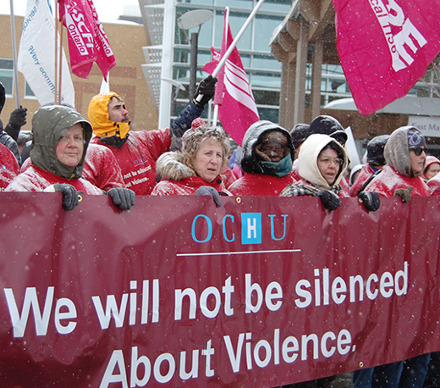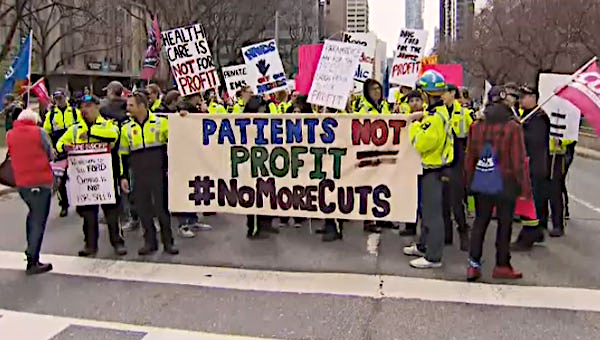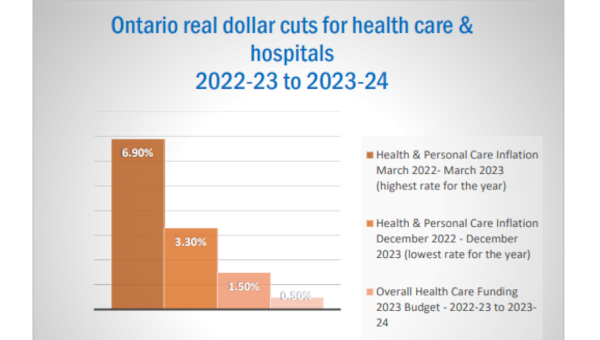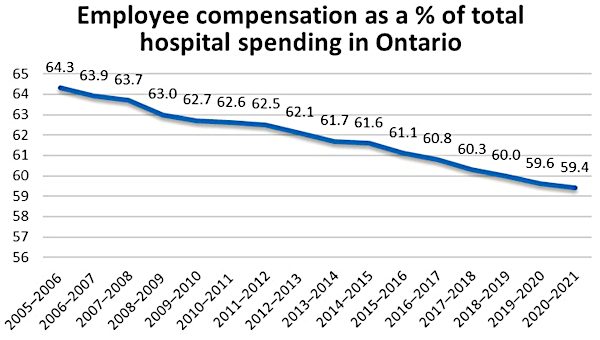According to healthcare workers interviewed this past year by the Ontario Council of Hospital Unions (OCHU)/Canadian Union of Public Employees (CUPE), the health and wellbeing of the individuals devoted to caring for our health seems to be increasingly at risk from angry, frustrated, or out of control patients. Their experiences are chilling.
“Very quickly, the patient bolted to his feet with his hand and arm cocked, ran across the room and hit me in the nose and under the eye. I immediately fell backwards. I started to bleed, profusely, from my nose. I couldn’t breathe. I started to panic.”
A Chronic and Widespread Problem
Every one of the 150 registered practical nurses (RPNs) from across Ontario attending a conference on violence in Kingston in January, 2016, reported that they have been assaulted at work. A survey of paramedics in Ontario and Nova Scotia found that 75% had
experienced violence in the previous year. 67% were verbally assaulted. 26% had been subjected to physical assault. Studies of nurses and personal support workers find disturbing rates of violence. Fewer studies have explored violence experienced by workers in other healthcare occupations – but clearly anyone who is dealing with patients and other members of the public are at risk.
Recently, several nurses in Ontario suffered serious injuries from patient attacks. In one case the nurses were repeatedly punched in the head, with one losing consciousness after being thrown against a wall. In another, a nurse was beaten unconscious with a lead pipe.
Healthcare workers in North Bay, Ontario, were polled in March of this year about violence on the job. Most of the respondents are registered practical nurses (RPNs) or personal support workers (PSWs) and most are women. The majority of those surveyed said they had been
subject to at least one incident of violence in the past year and many had experienced nine or more incidents. “86 per cent of the nurses and PSWs polled experienced incidents of physical violence such as pushing, hitting or having things thrown at them in the last year.”
“I’ve had my arm twisted… and after telling the patient, ‘you’re hurting me, you’re hurting me’ so they let go, they then reach up with their other arm to grab my neck.”
Not Just “Part of the Job”
Studies have found that nurses are subjected to more acts of violence than police officers or prison guards. The acceptance of violence in healthcare settings as part of the job is arguably rooted in cultural, economic and political dynamics. Somehow, we, and the society around us, have come to see it as normal
or as unavoidable. Violence in healthcare, in all its forms and degrees of severity, is seen somehow as intrinsic to the job.
“We help people. We are there for them in their last days. We keep them pain free as much as we can. That’s the nursing that I
went into. Not what we’re doing now. Not being police, not being security. Not rolling around on the floor in fights with patients.”“I go to work everyday knowing that I will be abused, either verbally or physically that day. So every day I prepare myself for
that. And I shouldn’t have to … Nobody should have to go into work knowing that they are going to possibly be assaulted one way or another in the workplace.”“It’s underreported because we chalk it up as it’s just something that’s part of the job.”
Violence in healthcare is not just a Canadian problem. According to recent study carried out in the United States, “Health care workplace violence is an underreported, ubiquitous, and persistent problem that has been tolerated and largely ignored.”1 Healthcare workers were found to require time off work due to violence four times more often than other types of injury. The study also identified that the most frequent victims were nurses and nursing aides. Patient caregivers in emergency departments, psychiatric units, and dementia units were found to be particularly at risk.
Studies that focused on violence in healthcare at a European level found that the incidence is greater in some countries than others. A
project called NEXT that explored the reasons behind nurses’ premature departure from their profession found that “exposure to frequent violent events was highest amongst nurses from France (39%), the United Kingdom (29%), and Germany (28%). In Norway (9%) and the Netherlands (10%), nurses were less exposed to frequent violent events.”
When it comes to protection of healthcare workers, Canadian jurisdictions have nothing to be proud of. A study of violence in long-term care facilities found that Canadian healthcare workers experience six times more incidents of physical violence than their counterparts in Scandinavian countries. The authors of the study said Canadian workers were experiencing “structural violence,” which they blame on “systemic and organizational factors” such as poor working conditions and lack of adequate support.
What exactly is workplace violence? According to the Canadian Centre for Occupational Health and Safety: It is any act in which a person is abused, threatened, intimidated or assaulted in his or her employment. Workplace violence includes:
- Threatening behaviour – such as shaking fists, destroying property or throwing objects.
- Verbal or written threats – any expression of an intent to inflict harm.
- Harassment – any behaviour that demeans, embarrasses, humiliates, annoys, alarms or verbally abuses a person and that is known or would be expected to be unwelcome. This includes words, gestures, intimidation, bullying, or other inappropriate activities.
- Verbal abuse – swearing, insults or condescending language.
- Physical attacks – hitting, shoving, pushing or kicking.
The European Agency for Safety and Health at Work states there is no uniform definition for workplace violence. However, it is generally
agreed that, “Violence is a generic term that covers all kinds of abuse” including “homicide, assault, threats, mobbing
and bullying; in effect, all behaviour that humiliates degrades or damages a person’s well-being, value and dignity.”
“I’ve seen my co-workers – and myself – be ripped apart verbally. I’ve been called awful… names over something so small as not getting someone a hot blanket for the bed or the coffee being cold or not getting rid of someone’s old water when I brought them new ice water.”
Workplace compensation statistics grossly underestimate the actual number of cases because many threats or acts of violence against
healthcare workers go unreported. Underreporting is partly a result of the long-standing culture of acceptance and partly because the victims – the healthcare workers – fear retribution from their employers or even the patients.
“Everybody has a right to speak up and to voice their concerns. And it’s just a shame that we’re made to feel that if you speak up, they’re going to put an X on your back, and they’re going to target you.”
“We don’t report a lot of things that happen to us because we fear we’ll just get told we did something wrong, or we didn’t
deal with the situation appropriately.”
Understaffing has increased frustration among patients and their families rendering healthcare workers more vulnerable to attack.
“A lot of the … verbal threats – someone threatening to throw food at you – or literally throwing food at you – a lot of those frustrations could be avoided if we had staff to meet needs in a timely manner … we’d have more face time with the patients, to establish that rapport, to build that relationship with them.”
Healthcare workers report that sick workers are not replaced and they often work short of the required number of personnel.
“Even if you’re sick, sometimes you come in because you know you’re not being replaced. And the employer plays on that. They know that. They know we’re there for each other. So if somebody’s … not feeling their best – you know what? They’ll come in if they have to because they know they aren’t going to be replaced.”
Legal Rights
Canadian law, as is the case in most jurisdictions, has language in place to protect healthcare workers from violence at work. Public
attention was galvanized on this issue in 2005 when a hospital nurse in Windsor, Ontario, named Lori Dupont, was murdered on the job by a
doctor with whom she had had a previous relationship. She had reported to her employer that she was afraid of him but was largely ignored. This tragic case resulted in demands for improvement to Ontario’s Occupational Health and Safety Act (OSHA). The act now requires that employers carry out assessments for violence, at least once per year, and that they prepare and maintain policies and programs for preventing violence and harassment.
Still, there are real limitations to healthcare workers rights under existing laws – especially when it comes to violence. Ontario
legislation, OHSA Section 25.2(h), states that, “the employer must take every precaution reasonable in the circumstances for he
protection of the worker.” Unfortunately, this clause is open to interpretation and does not directly address the issue of violence. Furthermore, healthcare workers have only a very limited right to refuse work they deem to be unsafe.
Better Legal Protection
Under Canada’s Criminal Code, Section 270, assaulting a police officer could result in a penalty ranging from 6 month to five years in prison and a $5,000 fine. There is no equivalent penalty for assaulting a healthcare worker on the job! These protections under the health and safety act are not enough. Most attacks on healthcare workers should be seen for what they really are – criminal acts.
There are precedents in the United States. Healthcare workers in New York State are protected under criminal law. In 2010, it became a
felony to assault a nurse on the job – a protection already given to emergency responders. In January, 2016, the law was expanded to
include any healthcare personnel providing direct patient care. Many states have enacted similar laws. The issue of whether or not the mental competency of the perpetrator of violence precludes criminal intent is decided by the justice system.
“It can be pretty scary sometimes. I have gone to codes [code whites, i.e. violence alerts] where patients have had weapons … I know we have called police in the past to help with those situations but I know the police have been told they are not to touch the patients unless someone is actively charging the patient.”
What Needs to be Done?
Violence permeates all aspects of our society. Violence against women remains a widespread social problem, resulting in injury, death, emotional trauma, and insecurity. In Canada, the majority of healthcare workers are women. Whether because of the gender make-up of the workforce or the ubiquity of violence against women in our culture, workplace violence is a significant problem for women working in healthcare. The International Council of Nurses reported that, “Nurses are the healthcare workers most at risk, with female nurses considered the most vulnerable.”
At the root of the violence problem is the notion in the medical industry that healthcare workers are fundamentally not as valuable as the people that they care for – that they are in service. Gender and social class render them less deserving. That is not to say that workplace violence is limited to attacks on women. Healthcare workers of all genders can be, and have been, victims of violence in all it forms and degrees, indicating a general disregard for the safety of an entire segment of the population. But the predominantly female composition of the workforce is a credible explanation for the fact that violence is routinely experienced by this group without any of the responses that are routine for assaults on other first responders.
As we know from comparative studies of other countries, strategies can be employed to reduce or eliminate the threat of violence – within the culture at large and within healthcare.
On an institutional level, there are some straightforward and practical solutions that could help to prevent violence in
healthcare. It seems, though, that limited healthcare funding has made some employers resistant to spending money on adequate staffing, alarm systems, video monitoring, and security.
“The patient/staff ratio – the more patients you’re working with, the more at risk everybody else is of making an error or being
injured. The Security presence as well is lacking up where we work … after you’ve had to restrain a patient and be physical with them it makes it harder to work with them. It puts you at risk for further incidents with those individuals … I think there needs to be a lot of focus and education on the staff safety, and letting the staff know that they are supported, that that they can talk to management about it.”
The Ontario Council of Hospital Unions (OCHU)/Canadian Union of Public Employees (CUPE) has identified measures to deal with the problem of violence directed against staff. In bargaining they will pursue:
- posting signs indicating that aggressive or violent, verbal or physical behaviour will not be tolerated in this facility;
- charging patients, family members and visitors who are violent;
- defining violence to include verbal harassment;
- protecting members who report violence from reprisal;
- reviewing hospital no-restraint policies;
- providing full disclosure of violent patients;
- updating flagging systems;
- providing for paid training of staff;
- requiring mandatory reporting of violent patients between institutions;
- requiring the full staffing of units dealing with violent patients;
- requiring disclosure of potential violent behaviour from police and the crown;
- providing personal alarms, locked stations and barriers;
- providing paid duty policing on units where there are violent patients;
- abiding by mandatory reporting of assaults;
- abiding by mandatory debriefings of any assaults;
- not counting time lost to violent assault against attendance management;
- importing the relevant provisions of the occupational health and safety act into the collective agreement.
Healthcare workers throughout the world should take heed of the recommendations made by the by OCHU/CUPE, which strongly encourages healthcare workers to stand up for their rights. Here are a few key actions they recommend to their members:
- If you experience violence, REPORT it. Report to your employer and your union all cases of violence or harassment as they are defined under the health and safety act. Make sure your joint health and safety committee is informed.
- Demand that your employer follow – to the letter and beyond – all of the requirements introduced under recent legislative changes. Demand such safeguards as personal monitors, alarms, adequate and consistent identification of potentially violent patients.
- Demand adequate staffing to deal with the workload and particular demands of the job. Staffing might include trained security personnel where needed who have with the power to intervene. You should never be alone with someone who has been identified as posing a risk unless adequate safeguards have been implemented.
- Share your stories of violence with your union and let them share your stories with the public, with administrators, and with regulators. The broader community needs to know what is happening.
- Demand that acts of violence against healthcare workers be considered criminal.
- And demand “whistle-blower” protection for workers with the courage to speak out about this shameful state of affairs.
Violence in healthcare must not remain a dirty little secret. The health of healthcare workers is a barometer of the health of the
healthcare system. By safeguarding healthcare workers – on a province-wide and international level – we can contribute not only to their wellbeing, but can help to improve our precious healthcare systems for everyone. •
This article is adapted from a fact sheet produced by the Ontario Council of Hospital Unions (OCHU)/Canadian Union of Public Employees (CUPE) and an article to be published in a book on Gender, Health and Work in 2017 by the European Trade Union Institute.





